CHRONIC
'fire cannot be trusted' (Kautilya)
names
pyrotechne
tunic
meat
alchemistry
crude
thrown fire
in law
love's fire
illuminated
tourist
texts
sources
versions
ANTIQUE INCENDIARIES
480 BCE
Persians capture Athens with flaming hemp arrows.
413 BCE
During the Athenian attack on Sicily, the Syracusans loaded an old merchant ship with resinated fire and let it drift toward the Athenian fleet.
350 BCE
Aeneas Tacticus mentions a mixture of sulphur, pitch, charcoal, incense and tow, which was packed in wooden vessels and thrown lighted upon the decks of the enemy’s ships. Later, as in receipts given by Vegetius, naphtha or petroleum is added.
332 BCE
During Alexander the Great’s siege of Tyre, the Phoenicians refitted a large transport ship as a floating chemical firebomb with sulfur, bitumen, pitch, and kindling material. The Phoenicians ignited the ship just before it struck a pier on the fortified island; the pier was destroyed.
304 BCE
resinous missiles used at siege of Rhodes. When Demetrius the Diodachi withdrew, leaving his siege equipment (including the Helepolis), the Rhodians sold that equipment to finance the building of the Colossus.
73 CE
Roman besiegers use naphtha-soaked arrows at Masada.
source: Adrienne Mayor, Greek Fire, Poison Arrows, and Scorpion Bombs.
GREEK FIRE
c. 673
Byzantine historian Theophanes credits its development to a Syrian Christian refugee, Kallinikos (Callinicus), an Umayyad refugee from Maalbek / Heliopolis (Syria) sought refuge from the conquest of Syria by Muslim armies in Byzantium. his name means “handsome winner.” had served with the Muslim military?
674-677
First used to repel the Arab (‘Saracen’) siege of Constantinople (Battle of Syllaeum) by Constantine Pogonatus, and again in 717-718 (wielded by Leo III).
In the seventh year of the siege, in 680, “Greek fire” was used in naval combat in the Battle of Kyzikos. Theophanes put the Muslim navy’s losses at 30,000 men. siege was broken, and the Muslims signed a 30-year truce. when news of the debacle at Kyzikos reached Caliph Mu'awiyah ibn Abi-Sufyan in Damascus, he promptly sent word to his dockyards in Alexandria to equip his galleys with the “firespouting devices” of the Byzantines.
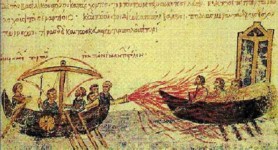
Reluctant to enter the holy city, the Umayyads mounted a battery of their fire-hurling mangonels on a nearby hill and began a systematic bombardment that was to last nine weeks. Despite Umayyad efforts to spare the shrine, a flaming projectile struck the Ka'bah midway through the siege. At first the kiswah, the black cloth covering the shrine [Ka'bah], caught fire, and then, as the heat became more intense, the Black Stone built into one corner of the Ka'bah split into three pieces.
For another month, neither 'Abd Allah [ra] nor the Umayyads were willing to budge. Then...the Umayyad forces received word to withdraw immediately, for Yazid had died and the troops were needed in Damascus. Nine years later, another Umayyad army returned to the holy city with its mangonels, catapults and oil incendiaries. For more than half a year fires raged around the haram until 'Abd Allah [ra] was finally slain.
9th cen.
increased demand for oil from a new fighting corps established in the regular Abbasid army called the naffatun, or naphtha troops, who manned the mangonels. they wore protective padding and fireproof uniforms, possibly made of hajar al-fatila or asbestos, which had been discovered in Tajikhstan in the 800s.
Baghdad was destroyed by the naffatun in 813.
Leo IX of Byzantium described “vases filled with quick-lime which were thrown by hand. When broken, the vase would let loose an overpowering odor which suffocates those who are near.”
915
Battle of Rashid. Sultan's fleet of 25 ships defeats Egyptian caliph's much larger fleet.
941
Byzantines also used against the Varangians (Vikings) and against the Venetians during the Fourth Crusade. Greek Fire was particularly helpful near the end of the empire's life when there were not enough inhabitants to effectively defend its territories.
'The Greeks have a fire resembling the lightning of heaven and when they threw it at us, they burned us; for this reason we could not overcome them.' (Report of Luitprand of Cremona, on defeat of Russian fleet by Byzantines in 941).
Emperor Constantine Porphyrogenitus claimed that the secret “had been given by an angel to Constantine the Great, those imparting it were anathema, and one about to communicate it had been struck by lightning.”
11th cen.
Kedrenos reported that the secret of the fire was possessed by Lampros, a descendant of Kallinikos.
1108
Anna Komnena (b.1083), daughter of Emperor Alexios I Komnenos: “This fire made by the following arts. From the pines and the certain such evergreen trees inflammable resin is collected. This is rubbed with sulfur and put into tubes of reed, and is blown by men using it with violent and continuous breath. Then in this manner it meets the fire on the tip and catches light and falls like a fiery whirlwind on the faces of the enemies.”
She also says it was used in the siege of Durazzo in 1108, when the Normans under Bohemond had mined under the walls, and the Byzantines had countermined until they reached the sap, when the appearance produced by these pyrotechnics would be terrifying but not very dangerous. The Normans, she said, had their beards signed but were not much injured.
1168
20,000 barrels of petroleum used by Shawar to burn down Fustat (Cairo) to prevent its recapture by the Franks.
"The episode in the romance De ortu Waluuanii where Sir Gawain must leap aboard a pirate ship attacking with Greek fire--unique in Arthurian literature--may be one of the earliest examples of the impact of changed military weaponry on the heroic imagination. ...Gawain confronts the new technology of the Greek fire as the adventure immediately precedes his true challenge, single combat for Jerusalem. Structurally, it is the final danger before the ultimate quest. Gawain must face the real horror, the weapon which was demoralizing the Crusaders, who actually fought to defend Jerusalem. Only after meeting this last test is Gawain qualified to act as champion for Empire and Faith. Gawain meets the challenge, destroys the weapon, and goes forth to protect Jerusalem. He is a true culture hero of his time and a man worthy to replace Arthur as the supreme knight of Britannia. Gawain must attack the seaman operating the machine, an anonymous figure far removed from the evil genius who created it. Once the new technology of Greek fire and gunpowder become the menace, the heroic age has ended." (MLD, AInt 1.1 (Spring 1986): 12-18)
13th cen.
the Liber ignium of Marcus Graecus
The Memoirs of Jean de Joinville
during the Seventh Crusade “It happened one night, whilst we were keeping night-watch over the tortoise-towers, that they brought up against us an engine called a perronel, (which they had not done before) and filled the sling of the engine with Greek fire. When that good knight, Lord Walter of Cureil, who was with me, saw this, he spoke to us as follows: “Sirs, we are in the greatest peril that we have ever yet been in. For, if they set fire to our turrets and shelters, we are lost and burnt; and if, again, we desert our defences which have been entrusted to us, we are disgraced; so none can deliver us from this peril save God alone. My opinion and advice therefor is: that every time they hurl the fire at us, we go down on our elbows and knees, and beseech Our Lord to save us from this danger.”
“So soon as they flung the first shot, we went down on our elbows and knees, as he had instructed us; and their first shot passed between the two turrets, and lodged just in front of us, where they had been raising the dam. Our firemen were all ready to put out the fire; and the Saracens, not being able to aim straight at them, on account of the two pent-house wings which the King had made, shot straight up into the clouds, so that the fire-darts fell right on top of them.”
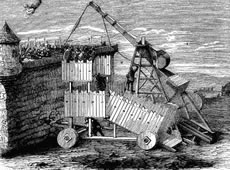
“This was the fashion of the Greek fire: it came on as broad in front as a vinegar cask, and the tail of fire that trailed behind it was as big as a great spear; and it made such a noise as it came, that it sounded like the thunder of heaven. It looked like a dragon flying through the air. Such a bright light did it cast, that one could see all over the camp as though it were day, by reason of the great mass of fire, and the brilliance of the light that it shed.”
“Thrice that night they hurled the Greek fire at us, and four times shot it from the tourniquet cross-bow.”
“Turkish engineers were steadily undermining the towers, which began to crumble beneath a ceaseless bombardment from the sultan's mangonels, a hail of enormous rocks and timber baulks. Lighter machines hurled pots of Greek fire or burning pitch which burst when they hit their targets and the sky was ablaze with naphtha arrows. Henri [III] tried to negotiate, but the implacable al-Ashraf would accept nothing but complete surrender. By 15 May the first wall and all its towers had been breached. Filling the moat with the bodies of men and horses as well as sandbags the Saracens swept through the main gate, encouraged by 300 drummers on camels. Charging on horseback down the narrow streets the Templar and Hospitaller brethren drove them out, but by evening the desperate Franks were forced to withdraw behind the inner wall. Next day many citizens put their wives and children on board ship for Cyprus, but unfortunately the weather was too bad to put out to sea. […] Just before dawn on Friday, 18 May 1291, the sultan ordered a general assault, announced by first one great kettle drum then by massed drums and a battery of trumpets and cymbals, 'which had a very horrible voice'. Mangonels and archers sent an endless shower of fire bombs into the doomed city, the arrows 'falling like rain', while Mameluke suicide-squads led by white-turbaned officers attacked through the dense smoke all along the wall in deep columns. […] Acre was now lost irretrievably. The terrified population, women, babies and old men, ran to the harbor in frantic despair, though many able-bodied citizens died fighting. King Henri had already sailed for home and there were too few ships. Horrible struggles took place on the crowded jetties and overloaded boats sank....To add to the horror a great storm blew up. The Saracens soon reached the jammed quays to butcher the screaming fugitives. […] After several days al-Ashraf offered good terms, which Fra. Pierre accepted and some Mamelukes were admitted. They hoisted the crescent flag of Islam but then began to rape the women and boys, whereupon the infuriated Templars killed them. The infidel flag was torn down and 'Beau Seant' hauled up again. That night the marshal sent sway the Commander, Tibald Gaudin, by boat with the Temple treasury, the holy relics, and some non-combatants. Next day the sultan once more proposed excellent terms, admitting that his men had got what they deserved, so Fra. Pierre when out to discuss surrender. He was immediately seized and beheaded. Some of the brethren were old men, most of them wounded and all exhausted, yet they decided to fight to the finish. They beat off assault after assault. 'They can fight the battle of the Lord and indeed be soldiers of Christ. Let them kill the enemy or die, they need not be afraid'. But the brethren had no reply to mangonel fire and the tunnels which riddled the foundations. On 28 May, the mines were fired. Part of the massive wall collapsed and 2,000 Turkish troops poured in to meet a bloody reception. The weight was too much for the tottering building, which came crashing down and Saracens and brethren perished together in a flaming hecatomb.”
“The Poor Knights' most lasting achievement, their contribution towards the overthrow of the Church's attitude to usury, was economic. No medieval institution did more for the rise of capitalism. Yet the Templars deserve to be remembered not as financiers but as the heroes of Acre, that strange fellowship of death who died for Christ with such disturbing courage.”
1304
Edward I uses wildfire at Stirling in Scotland.
1453
Greek fire used along with gunpowder and cannon at siege of Constantinople.
Leonardo da Vinci gives recipes for Greek fire composed of willow charcoal, saltpetre (sale nitro), alcohol (aqua vite), sulpur, pitch, frankincense and camphor, boiled together and spread over Ethiopian wool (lana etopica).
1643
Fire-lances tipped with incendiaries used in the siege of Bristol.
source: J. R. Partington, History of Greek Fire 20-21.
Desmond Seward, The Monks of War
Dupre, born in Dauphine, claimed to have rediscovered it, and sold the recipe to Louis XV. A paper published for Napoleon claims to have rediscovered the lost recipe for Greek fire, with the title “Weapons for the Burning of Armies.”
A form of Greek fire was employed by General Patrick Gilmore during the American Civil War / When the American Civil War started in 1861, the use of Greek fire was threatened but, in fact, never used?
Greek faith they gave us eighty years,
And then Greek fire.
But better all their fires of scathe
Than one hour’s trust in Yankee faith.
~ William Gilmore Simms
PHOSPHOROUS
Hennig Brandt discovers phosphorous in experiments at his home in Hamburg, and sells it to Daniel Kraft.
Daniel Kraft gives demonstrations of phosphorous to the crowned heads of Europe -- including, on 15 Sept. 1677, a display at Ranelagh House (Robert Boyle's sister's residence) in Pall Mall. As part of his demonstration, Kraft wrote 'DOMINI' in phosphorous on a sheet, and uses it to light gunpowder.
In Hanover in 1677, Leibniz is in the audience. Johannes Kunckel discovers that he can make phosphorous by heating any organic substance. Brandt sets up as an alchemist in Hanover, working for Duke Johann Frederick of Saxony; Leibniz publishes an account.
Evelyn attends a demonstration by Frederick Slare at Pepys' house. "This phosphorous was made out of human blood and urine, elucidating the vital flame or heat, in animal bodies. A very noble experiment."
The Royal Society posthumously publishes Robert Boyle's essay on phosphorous, based on his experiments of 30 Sept. 1680. Boyle called this substance "aerial nocticula", and proposed its use as a safety light in the holds of ships, sealed in glass bulbs to attract fish, or to illuminate clock dials. He notes that a paint brush dipped in phosphorous resembles a burning taper.
Boyle's assistant, Ambrose Godfrey Hanckwitz (from Nienburg in Saxony) manufactured phosphorous, selling an ounce for 50s wholesale, £3 retail.
Marie Jankovitz presents the first known case of phossy jaw in Vienna.
Arthur Albright establishes a phosphorous works at Oldbury, near the Staffordshire coal field and Chances' alkali works.
"Corroding gases emitted from the chemical works in the heart of the town so completed the blight that even grass and the hardiest of plants failed not to succumb. Not be incessant labour could Oldbury housewives keep fire-irons or other utensils of bright steel in any desirable condition of cleanliness; metal tarnished in a single night, and in process of time faded away as they had been petals of a fading flower."
A giant mound of by-products form the Leblanc process of making soda ash grew up at the alkali works. It was known as "Blue Billy" by neighbours.
Oldbury's four blast furnaces were known as the "Four Moons"; there was no need for street lighting in the town until 1875.
source: John Emsley, The Shocking History of Phosphorus, a Biography of the Devil’s Element.
F. W. Hackwood, Oldbury and Round About (Birmingham, 1915).
WHITE PHOSPHOROUS
WP is believed to have been first used by Fenian arsonists in the form of a solution of WP in carbon disulfide. This mixture was known as "Fenian fire" and allegedly was also used by I.W.W. activists in the early 20th century.
1915
Along the 28 km front at Loos on 25 Sept. 1915, the British fired 5,500 gas taks containing 150 tons of chlorine, 1,100 smoke pots, 25,000 white phosphorus hand grenades, and 10,000 high explosive mines from Stokes mortars.
Britain's army introduced its first factory-built WP grenades in late 1916.
Albright & Wilson produced phosphorous-filled shells, hand and rifle grenades such as Fumite and Threlfallite (filled with mixture of phosphorous and petrol), "Chinese tumblers" and "plum puddings", to be used in trench warfare.
The Flying Corps were armed with wind-direction indicators ("candles"), "toffee" bombs (a mixture of white and "plastic", i.e. not fully converted amorphous phosphorous) against zeppelins and kite balloons.
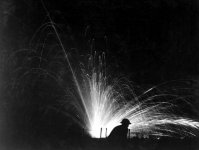
Albright & Wilson added mustard gas and phosgene production to their war jobs.
1939-1945
In World War II, white phosphorus mortar bombs, shells, rockets and grenades were used extensively by American, Commonwealth, and to a lesser extent Japanese forces, as well, in both smoke-generating and antipersonnel roles. At the start of the Normandy campaign, 20% of American 81mm mortar rounds were WP. At least five American Medal of Honor citations mention their recipients using white phosphorus grenades to clear enemy positions. In the 1944 liberation of Cherbourg alone, a single U.S. mortar battalion, the 87th, fired 11,899 white phosphorus rounds into the city.
In 1940, when the invasion of Britain seemed imminent, the phosphorus firm of Albright and Wilson suggested that the British government use a material similar to Fenian fire in several expedient incendiary weapons. The only one fielded was the Grenade, No. 76 or Special Incendiary Phosphorus grenade, which consisted of a glass bottle filled with a mixture similar to Fenian fire, plus some latex (c.f. Molotov cocktail, Greek fire). It came in two versions, one with a red cap intended to be thrown by hand, and a slightly stronger bottle with a green cap, intended to be launched from the Northover projector (a crude 2.5 inch blackpowder grenade launcher). Instructions on each crate of SIP grenades included the observations, inter alia:
- Store bombs (preferably in cases) in cool places, under water if possible.
- Stringent precautions must be taken to avoid cracking bombs during handling.
It was generally regarded as overly dangerous to its own operators.
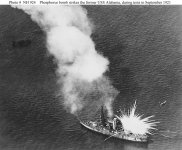
The use of soaps to thicken and stabilise naphtha also led to the formulation of napalm in the 1940s.
In May 1940, Albright & Wilson also took an order to make 250,000 Molotov cocktails to arm the civilian population in anticipation of an invasion by Hitler's forces. They created a national shortage of screw-top beer and milk bottles which they filled with a solution of phosphorus dissolved in benzene. These were filled by women from the local carpet mill.
source: Richard Threlfall,
The Story of 100 Years of Phosphorus Making,
1851-1951.
30 May 1942: RAF raid on Cologne. estimates that 560 30lb phosphorus bombs (among other incendiaries) fall on the city. 13,000 buildings destroyed.
'a large phosphorus bomb fell directly outside...the people nearest the door now gave way to an indescribable panic... Terrible scenes took place, since all of us saw certain death in front of us, with the only way out a sea of flames. We were caught like rats in a trap. Doors were thrown on the canister by screaming people and more smoke and heat poured in... some collapsed and never woke up again. Three soldiers committed suicide. I begged my husband to beat back the flames with our blanket but he was unable to do so. My hair began to singe...'
fire-storms were reported by the US Strategic Bombing Survey in Hamburg, Kassel, Darmstadt and Dresden (1945). 'The bombing of an already burning area with HE [high explosives] serves to impede the efforts of local fire fighters, but heavy demolition bombs are also effective means for extinguishing fires. Fragmentation bombs have bene found to be reasonably satisfactory in restraining firemen without impeding the progress of the fires. These of course must be detonated while the fire fighting is in progress...'
9/10 March 1945
US incendiary air attack on Tokyo. 267,171 buildings destroyed, 83,798 killed, 40,918 wounded.
Elmsley 139
account of Erica Wilkan, who survived 'Operation Gomorrah', the raid on Hamburg in 1943 which produced a firestorm on 27 July (quoted in Martin Middlebrook, The Battle of Hamburg, and in Emsley p. 132)
J. B. Fischer, Incendiary Warfare (McGraw-Hill, 1946), p. 9.
French forces use napalm bombs on Algerian guerilla units and to destroy large numbers of villages
WP munitions were also used extensively by both sides in the Korean War and again in Vietnam.
Description of a napalm victim in Korea:
'In front of us a curious figure was standing a little crouched, legs straddled, arms held out from his sides. He had no eyes, and the whole of his body, nearly all of which was visible thorugh the tatters of burned rags, was covered with a hard black crust speckled by yellow pus... He had to stand because he was no longer covered with a skin, but with a crust-like crackling which broke easily.'
WP was used with napalm in Vietnam for attacks on personnel and as incendiary weapons against inflammable targets, since WP, which ignites spontaneously, helps to ensure the ignition of the napalm.
US jets feed the fire in the U Minh forest with napalm and WP.
An article looking back at the Vietnam war published in 1996 by a US armoured unit (1st Battalion, 69th Armor) referred to "Willie Pete" weapons and their use in getting North Vietnamese troops to leave their positions: "Our normal procedure was to fire these things at a hillside as soon as possible in order to get them out of the fighting compartment."
Israeli air force uses napalm extensively against Egyptian troops in the Sinai desert in 1967, and 15 villages and refugee camps along the River Jordan in 1968. During the "War of Attrition", Israeli aircraft drop napalm bombs and delayed-action fragmentation bombs in heavily-populated Nile Delta area.
source: R. Cutforth, Manchester Guardian, 1 Mar. 1952. Cited in Lumsden p. 45.
Lumsden p. 55.
source: Paul Reynolds, 'White Phosphorous: Weapon on the Edge', BBC News, 16 Nov. 2005
According to an undated ANSA article, white phosphorus was used by Saddam Hussein during the Halabja poison gas attack: (transl.) "On the morning of March 16, 1988, the Iraqi aerial forces bombed several times the city with a chemical cocktail of nerve agents: yperite, tabun, VX, napalm and white phosphorus." WP use had not been previously mentioned in other reports on Halabja.
the Army Chemical Materials Agency prepared a report entitled Summary of Some Chemical Munitions Sea Dumps by the United States which detailed the history of dumping incidents for weapons that included mustard gas, lewisite, cyanide and white phosphorus. In 2001, another report, entitled Offshore disposal of chemical agents and weapons conducted by the United States, corroborated the dumping.
The Iraqi military itself was accused of using WP as a chemical weapon against both combatants and non-combatants. A declassified 1995 US Department of Defense document states:
SUMMARY: IRAQ HAS POSSIBLY EMPLOYED PHOSPHOROUS CHEMICAL WEAPONS AGAINST THE KURDISH POPULATION IN AREAS ALONG THE IRAQI-TURKISH-IRANIAN BORDERS. KURDISH RESISTANCE IS LOSING ITS STRUGGLE AGAINST SADDAM HUSSEIN'S FORCES. KURDISH REBELS AND REFUGEES' PERSONAL OBSERVATIONS AND PERCEPTIONS ARE PROVIDED.
(…) DURING THE BRUTAL CRACKDOWN THAT FOLLOWED THE KURDISH UPRISING, IRAQI FORCES LOYAL TO PRESIDENT SADDAM ((HUSSEIN)) MAY HAVE POSSIBLY USED WHITE PHOSPHOROUS (WP) CHEMICAL WEAPONS AGAINST KURDISH REBELS AND THE POPULACE IN ERBIL (GEOCOORD:3412N/04401E) (VICINITY OF IRANIAN BORDER) AND DOHUK (GEOCOORD:3652N/04301E) (VICINITY OF IRAQI BORDER) PROVINCES, IRAQ.
In the December 1994 battle for Grozny in Chechnya, every fourth or fifth Russian artillery or mortar round fired was a smoke or white phosphorus round.
The US admits it used napalm in Iraq. "A 1980 UN convention banned the use against civilian targets of napalm, a terrifying mixture of jet fuel and polystyrene that sticks to skin as it burns. The US, which did not sign the treaty, is one of the few countries that makes use of the weapon. It was employed notoriously against both civilian and military targets in the Vietnam war.
The upgraded weapon, which uses kerosene rather than petrol, was used in March and April, when dozens of napalm bombs were dropped near bridges over the Saddam Canal and the Tigris river, south of Baghdad.
"We napalmed both those [bridge] approaches," said Colonel James Alles, commander of Marine Air Group 11. "Unfortunately there were people there ... you could see them in the [cockpit] video. They were Iraqi soldiers. It's no great way to die. The generals love napalm. It has a big psychological effect."
A reporter from the Sydney Morning Herald who witnessed another napalm attack on 21 March on an Iraqi observation post at Safwan Hill, close to the Kuwaiti border, wrote the following day: "Safwan Hill went up in a huge fireball and the observation post was obliterated. 'I pity anyone who is in there,' a Marine sergeant said. 'We told them to surrender.'
...The Pentagon said it had not tried to deceive. It drew a distinction between traditional napalm, first invented in 1942, and the weapons dropped in Iraq, which it calls Mark 77 firebombs. They weigh 510lbs, and consist of 44lbs of polystyrene-like gel and 63 gallons of jet fuel."
A report by Darrin Mortenson of the North County Times in California, embedded with the 2nd Battalion, 1st Marine Regiment, reveals that WP is being used as a weapon:
"After pounding parts of the city for days, many Marines say the recent combat escalated into more than they had planned for, but not more than they could handle. "It's a war," said Cpl. Nicholas Bogert, 22, of Morris, N.Y.
Bogert is a mortar team leader who directed his men to fire round after round of high explosives and white phosphorus charges into the city Friday and Saturday, never knowing what the targets were or what damage the resulting explosions caused. "We had all this SASO (security and stabilization operations) training back home," he said. "And then this turns into a real goddamned war."
Just as his team started to eat a breakfast of packaged rations Saturday, Bogert got a fire mission over the radio.
"Stand by!" he yelled, sending Lance Cpls. Jonathan Alexander and Jonathan Millikin scrambling to their feet.
Joking and rousting each other like boys just seconds before, the men were instantly all business. With fellow Marines between them and their targets, a lot was at stake.
Bogert received coordinates of the target, plotted them on a map and called out the settings for the gun they call "Sarah Lee."
Millikin, 21, from Reno, Nev., and Alexander, 23, from Wetumpka, Ala., quickly made the adjustments. They are good at what they do. "Gun up!" Millikin yelled when they finished a few seconds later, grabbing a white phosphorus round from a nearby ammo can and holding it over the tube. "Fire!" Bogert yelled, as Millikin dropped it.
The boom kicked dust around the pit as they ran through the drill again and again, sending a mixture of burning white phosphorus and high explosives they call "shake 'n' bake" into a cluster of buildings where insurgents have been spotted all week.
During Operation Phantom Fury (the second major assault on Fallujah), Washington Post reporters embedded with Task Force 2-2, Regimental Combat Team 7, wrote on November 9 2004 that "Some artillery guns fired white phosphorous rounds that create a screen of fire that cannot be extinguished with water."
This claim was also confirmed by members of the US military itself in the March-April 2005 issue of Field Artillery, a journal published by the US Department of Defense, in an article titled "TF 2-2 in FSE AAR: Indirect Fires in the Battle for Fallujah" by Captain James T. Cobb. Cobb writes:
"WP proved to be an effective and versatile munition. We used it for screening missions at two breeches and, later in the fight, as a potent psychological weapon against the insurgents in trench lines and spider holes when we could not get effects on them with HE. We fired "shake and bake" missions at the insurgents, using WP to flush them out and HE to take them out."
On November 15 2005, Dept. of Defense spokesman Lieutenant-Colonel Barry Venable confirmed to the BBC that WP had been used as an antipersonnel weapon in Fallujah:
Yes, it was used as an incendiary weapon against enemy combatants. When you have enemy forces that are in covered positions that your high explosive artillery rounds are not having an impact on and you wish to get them out of those positions, one technique is to fire a white phosphorus round into the position because the combined effects of the fire and smoke - and in some case the terror brought about by the explosion on the ground - will drive them out of the holes so that you can kill them with high explosives (i.e. "shake & bake").
On November 30, 2005, General Peter Pace justified use of WP, declaring that WP munitions were a "legitimate tool of the military", used to illuminate targets and create smokescreens, adding: "It is not a chemical weapon. It is an incendiary. And it is well within the law of war to use those weapons as they're being used, for marking and for screening". Peter Pace then made the point that conventional weapons can be more dangerous than non-conventional weapons: "A bullet goes through skin even faster than white phosphorus does."
British troops have also used white phosphorus in Iraq, Defence Secretary John Reid admitted. But Reid insisted that the highly flammable chemical substance, which can burn flesh, was not used against civilians. "We do not use it for anything other than a smokescreen to protect our troops when in action." Labour chairman of the Foreign Affairs Committee Mike Gapes suggested that although white phosphorous was defined as an "incendiary," that treaties on chemical weapons should be strengthened so they covered the substance. The Americans had mishandled the issue by initially denying using white phosphorus as a "public relations disaster for them," said Gapes. The opposition Conservative shadow foreign secretary Liam Fox said there needed to be more openness from the US Pentagon, but he also defended the use. "Although white phosphorus is a brutal weapon, we need to remember that we were talking about some pretty brutal insurgents," he said.
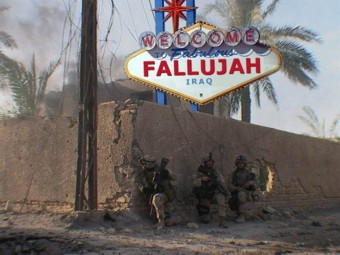
source: 'A Declassified from the US Dept of Defense calls WP a 'Chemical Weapon,' The Cat's Blog, 21 Nov. 2005; see also 'The Mysterious Case of White Phosphorous', The Cat's Blog, 1 Dec. 2005
sources: Globalsecurity.org and San Diego Union-Tribune
source: Darrin Mortensen, 'Violence Subsides for Marines in Fallujah', the North County Times, 14 Sept. 2006
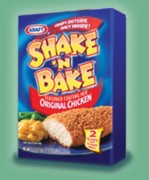
Fallujah:
The Hidden Massacre, documentary by
Sigfrido Ranucci
(RaiNews24, 8 Nov. 2005)
source: UK follows US in admitting use of white phosphorus in Iraq IRNA - Islamic Republic News Agency London, Nov 16, 2005
On July 22, Wayne Madsen Report first reported that white phosphorous, a substance that burns through the skin of its victims, was being used against Lebanese civilians, including children, by Israeli forces. Reuters on July 24 from Paris: "Lebanon's president accused Israel on Monday of using phosphorous bombs in its 13-day offensive and urged the United Nations to demand an immediate ceasefire." CNN also reported on the use of white phosphorous by Israel.
Further evidence from independent journalist Dahr Jamail in Beirut, speaking to Amy Goodman on Democracy Now: "But without a doubt, I think the most important thing that people need to understand right now is that the Israelis are using white phosphorus in Southern Lebanon, and also it's been unconfirmed, but the Lebanese Army is reporting that they are using -- dropping cluster bombs from warplanes, as well, and other illegal munitions also. But that, as of yet, to be confirmed by an independent source."
It has been confirmed now.
"The Israeli government has admitted that it used controversial phosphorus weapons in its attacks against targets during its month long war in Lebanon this summer.
The chemical can be used in shells, missiles and grenades and causes horrific burning when it comes into contact with human flesh.
Mr Edery told Ms Gal-On: 'The IDF [Israel Defence Force] holds phosphorus munitions in different forms. The IDF made use of phosphorus shells during the war against Hizbullah in attacks against military targets in open ground.'
Ms Gal-On said that her original question to the government related to suspicions that Israel has been using experimental weapons in Gaza so she was surprised when she was offered a confirmation that Israel had used phosphorus weapons in Lebanon. "My original question was about the use of Dime [dense inert metal explosives] weapons by Israel in Gaza but instead I was given the answer to a different question," she said. "The use of phosphorus weapons in Lebanon is shocking and unacceptable."
Conal Urquhart, "Israel admits it used phosphorus weapons", Guardian 23 Oct. 2006. Thanks to Tom Jones for this reference.
Leaked e-mails reveal that the RAF is using White Phosphorus in Afghanistan:
"A female Harrier pilot 'couldn't identify the target', fired two phosphorus rockets that just missed our own compound so that we thought they were incoming RPGs [rocket-propelled grenades], and then strafed our perimeter missing the enemy by 200 metres," Major James Loden of 3 Para said.
Meanwhile, Canadian troops have tried -- unsuccessfully -- to clear thickets of ten-foot-high marijuana plants in Afghanistan using WP.




